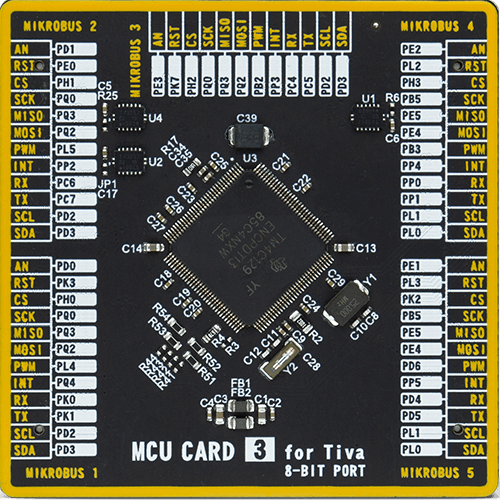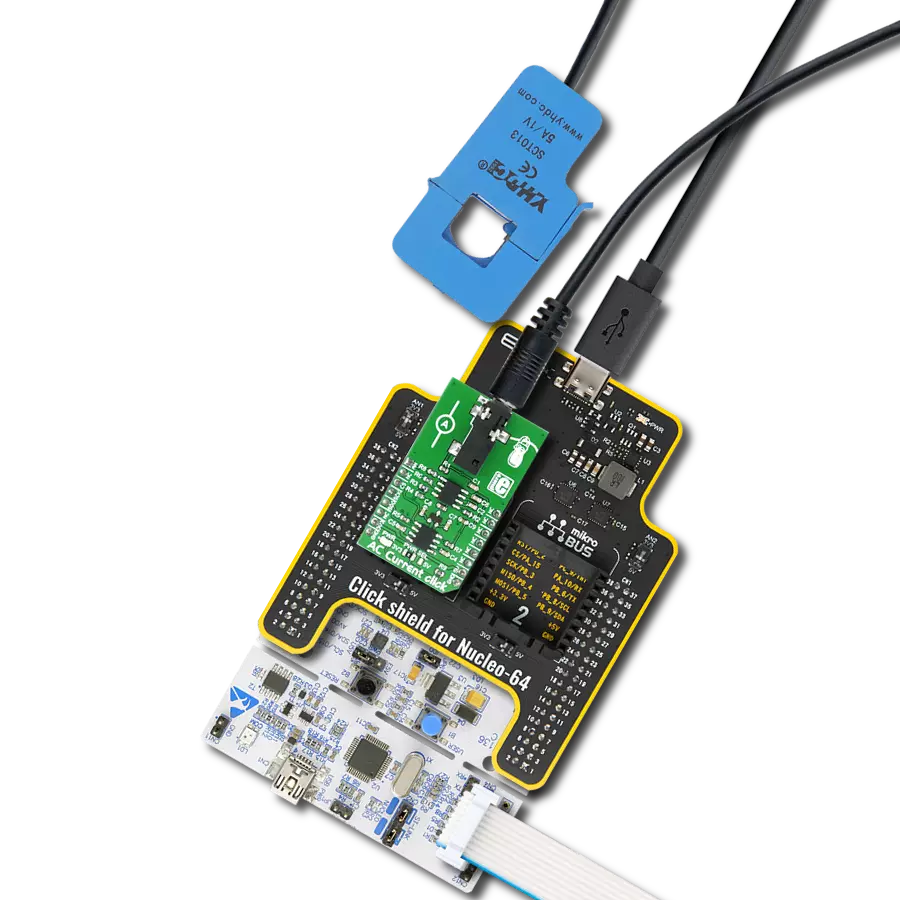释放我们解决方案的精准双向电流感应潜力,超越简单测量。赋予您的系统监控、分析和优化双向电力使用的能力,实现前所未有的控制。
A
A
硬件概览
它是如何工作的?
Current 7 Click基于INA381,这是一款来自德州仪器的高精度电流感应放大器。该电压输出电流感应放大器能够准确测量在电流感应电阻(也称为电流分流电阻)上产生的电压,其共模范围可延伸至负电源轨下方14V至高达80V,允许进行低端或高端电流感应。零漂移拓扑结构使其能够在宽温度范围内进行高精度测量,最大输入偏移电压低至70μV。此Click板™具有两种与MCU通信的方式。INA282的模拟输出信号可以通过使用Microchip的MCP3221,将其转换为12位分辨率的数字值,该转换器通过2线I2C兼容接口
进行转换,或者可以直接发送到标记为AN的mikroBUS™插座的模拟引脚。MCP3221提供单端输入,具有低功耗,最大转换电流和待机电流分别为250μA和1μA。在标准模式下,数据传输速度可达100kbit/s,在快速模式下可达400kbit/s。选择可以通过板载SMD跳线标记为OUT SEL,设置到标记为AN和ADC的适当位置来执行。INA282还允许在标记为REF1和REF2的板载接头上连接外部电压信号作为设备的参考电压。此参考电压决定了输出如何响应特定输入条件。参考电压控制电阻R5和R6的可配置设置
允许INA282在单向和双向应用中使用。有关这些操作模式的更多信息,请参阅附带的datasheet。此Click板™可以通过VCC SEL跳线选择使用3.3V和5V逻辑电压水平。这种方式下,3.3V和5V能力的MCU都可以正确使用通信线。此外,还可以通过标记为PWR SEL的跳线选择INA282的电源供应,可以从范围为2.7V至18V的外部电源终端或mikroBUS™电源轨供电。然而,此Click板™配备了包含易于使用的函数和示例代码的库,可作为进一步开发的参考。

功能概述
开发板
Fusion for TIVA v8 是一款专为快速开发嵌入式应用的需求而特别设计的开发板。它支持广泛的微控制器,如不同的32位ARM® Cortex®-M基础MCUs,来自Texas Instruments,无论它们的引脚数量如何,并且具有一系列独特功能,例如首次通过WiFi网络实现的嵌入式调试器/程序员。开发板布局合理,设计周到,使得最终用户可以在一个地方找到所有必要的元素,如开关、按钮、指示灯、连接器等。得益于创新的制造技术,Fusion for TIVA v8 提供了流畅而沉浸式的工作体验,允许在任何情况下、任何地方、任何
时候都能访问。Fusion for TIVA v8开发板的每个部分都包含了使同一板块运行最高效的必要组件。一个先进的集成CODEGRIP程序/调试模块提供许多有价值的编程/调试选项,包括对JTAG、SWD和SWO Trace(单线输出)的支持,并与Mikroe软件环境无缝集成。此外,它还包括一个干净且调节过的开发板电源供应模块。它可以使用广泛的外部电源,包括电池、外部12V电源供应和通过USB Type-C(USB-C)连接器的电源。通信选项如USB-UART、USB HOST/DEVICE、CAN(如果MCU卡支持的话)和以
太网也包括在内。此外,它还拥有广受好评的 mikroBUS™标准,为MCU卡提供了标准化插座(SiBRAIN标准),以及两种显示选项,用于TFT板线产品和基于字符的LCD。Fusion for TIVA v8 是Mikroe快速开发生态系统的一个组成部分。它由Mikroe软件工具原生支持,得益于大量不同的Click板™(超过一千块板),其数量每天都在增长,它涵盖了原型制作和开发的许多方面。
微控制器概述
MCU卡片 / MCU

类型
8th Generation
建筑
ARM Cortex-M4
MCU 内存 (KB)
512
硅供应商
Texas Instruments
引脚数
128
RAM (字节)
262144
使用的MCU引脚
mikroBUS™映射器
“仔细看看!”
Click board™ 原理图

一步一步来
项目组装
实时跟踪您的结果
应用程序输出
1. 应用程序输出 - 在调试模式下,“应用程序输出”窗口支持实时数据监控,直接提供执行结果的可视化。请按照提供的教程正确配置环境,以确保数据正确显示。

2. UART 终端 - 使用UART Terminal通过USB to UART converter监视数据传输,实现Click board™与开发系统之间的直接通信。请根据项目需求配置波特率和其他串行设置,以确保正常运行。有关分步设置说明,请参考提供的教程。

3. Plot 输出 - Plot功能提供了一种强大的方式来可视化实时传感器数据,使趋势分析、调试和多个数据点的对比变得更加直观。要正确设置,请按照提供的教程,其中包含使用Plot功能显示Click board™读数的分步示例。在代码中使用Plot功能时,请使用以下函数:plot(insert_graph_name, variable_name);。这是一个通用格式,用户需要将“insert_graph_name”替换为实际图表名称,并将“variable_name”替换为要显示的参数。

软件支持
库描述
该库包含 Current 7 Click 驱动程序的 API。
关键功能:
current7_read_voltage- 此功能读取原始ADC值并将其转换为相应的电压水平。current7_get_current- 此功能基于CURRENT7_NUM_CONVERSIONS的电压测量值读取输入电流水平[A]。current7_set_vref- 此功能设置Current 7 Click驱动器的电压参考。
开源
代码示例
完整的应用程序代码和一个现成的项目可以通过NECTO Studio包管理器直接安装到NECTO Studio。 应用程序代码也可以在MIKROE的GitHub账户中找到。
/*!
* @file main.c
* @brief Current7 Click example
*
* # Description
* This library contains API for Current 7 Click driver.
* The demo application reads current ( A ).
*
* The demo application is composed of two sections :
*
* ## Application Init
* Initializes I2C or AN driver and log UART.
*
* ## Application Task
* This is an example that demonstrates the use of the Current 7 Click board™.
* In this example, we read and display the current ( A ) data.
* Results are being sent to the Usart Terminal where you can track their changes.
*
* @author Nenad Filipovic
*
*/
#include "board.h"
#include "log.h"
#include "current7.h"
static current7_t current7;
static log_t logger;
void application_init ( void )
{
log_cfg_t log_cfg; /**< Logger config object. */
current7_cfg_t current7_cfg; /**< Click config object. */
/**
* Logger initialization.
* Default baud rate: 115200
* Default log level: LOG_LEVEL_DEBUG
* @note If USB_UART_RX and USB_UART_TX
* are defined as HAL_PIN_NC, you will
* need to define them manually for log to work.
* See @b LOG_MAP_USB_UART macro definition for detailed explanation.
*/
LOG_MAP_USB_UART( log_cfg );
log_init( &logger, &log_cfg );
log_info( &logger, " Application Init " );
// Click initialization.
current7_cfg_setup( ¤t7_cfg );
CURRENT7_MAP_MIKROBUS( current7_cfg, MIKROBUS_1 );
if ( I2C_MASTER_ERROR == current7_init( ¤t7, ¤t7_cfg ) )
{
log_error( &logger, " Communication init." );
for ( ; ; );
}
log_info( &logger, " Application Task " );
}
void application_task ( void )
{
float current = 0;
current7_get_current( ¤t7, ¤t );
log_printf( &logger, " Current : %.3f A\r\n", current );
log_printf( &logger, "--------------------\r\n" );
Delay_ms ( 1000 );
}
int main ( void )
{
/* Do not remove this line or clock might not be set correctly. */
#ifdef PREINIT_SUPPORTED
preinit();
#endif
application_init( );
for ( ; ; )
{
application_task( );
}
return 0;
}
// ------------------------------------------------------------------------ END
/*!
* @file main.c
* @brief Current7 Click example
*
* # Description
* This library contains API for Current 7 Click driver.
* The demo application reads current ( A ).
*
* The demo application is composed of two sections :
*
* ## Application Init
* Initializes I2C or AN driver and log UART.
*
* ## Application Task
* This is an example that demonstrates the use of the Current 7 Click board™.
* In this example, we read and display the current ( A ) data.
* Results are being sent to the Usart Terminal where you can track their changes.
*
* @author Nenad Filipovic
*
*/
#include "board.h"
#include "log.h"
#include "current7.h"
static current7_t current7;
static log_t logger;
void application_init ( void )
{
log_cfg_t log_cfg; /**< Logger config object. */
current7_cfg_t current7_cfg; /**< Click config object. */
/**
* Logger initialization.
* Default baud rate: 115200
* Default log level: LOG_LEVEL_DEBUG
* @note If USB_UART_RX and USB_UART_TX
* are defined as HAL_PIN_NC, you will
* need to define them manually for log to work.
* See @b LOG_MAP_USB_UART macro definition for detailed explanation.
*/
LOG_MAP_USB_UART( log_cfg );
log_init( &logger, &log_cfg );
log_info( &logger, " Application Init " );
// Click initialization.
current7_cfg_setup( ¤t7_cfg );
CURRENT7_MAP_MIKROBUS( current7_cfg, MIKROBUS_1 );
if ( I2C_MASTER_ERROR == current7_init( ¤t7, ¤t7_cfg ) )
{
log_error( &logger, " Communication init." );
for ( ; ; );
}
log_info( &logger, " Application Task " );
}
void application_task ( void )
{
float current = 0;
current7_get_current( ¤t7, ¤t );
log_printf( &logger, " Current : %.3f A\r\n", current );
log_printf( &logger, "--------------------\r\n" );
Delay_ms ( 1000 );
}
int main ( void )
{
/* Do not remove this line or clock might not be set correctly. */
#ifdef PREINIT_SUPPORTED
preinit();
#endif
application_init( );
for ( ; ; )
{
application_task( );
}
return 0;
}
// ------------------------------------------------------------------------ END

































